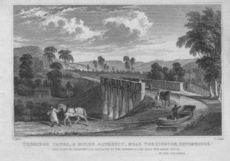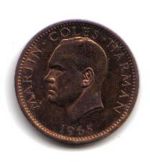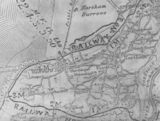Moreton House
Moreton House is a country house and estate near Bideford, North Devon, England.
Contents
The History of the Lands of Moreton House and District
Moreton House lies on the road to Abbotsham Village in rural North Devon. The house and lands were long the property of the famous Grenville family, Lords of the Manor of Bideford. Sir Hugh Stucley, Bart., inherited the property, together with Hartland Abbey (home of Sir Richard Grenville) and Affeton Castle from his father, Sir George Stucley. The house is a fine example of Georgian architecture with ornate gardens featuring two lakes, fountains, formal herbaceous borders, waterfalls, etc.
Sir Hugh Stucley
Sir Hugh was born on June 22, 1873 and his mother was Louisa, daughter of Sir Beville Grenville of Wellesbourne, Warwickshire. He served as a Lieutenant Commander in the Royal Navy. He was elected to the Bideford Town Council and served as Mayor of the Borough. It was the thirty-seventh time that a member of his family had served the Borough as Mayor. He was also elected to Devon County Council in 1906 and was a county alderman in 1908. His main interests were County Finance, and Education. Personal interests were fishing, shooting and landscape gardening. It was he who designed the beautiful gardens which Moreton House is well known for. He had a son, Sir Denis, who succeeded him and was also a Mayor of Bideford.
Lundy Coins
One link which is of interest to numismatists, is that Sir High N.Grenville Stucley was the presiding magistrate at the Petty Sessional Division court which tried the case of Supt. Bolt on behalf of the Director of Public Prosecutions v. Martin Coles Harman, charged with on the 5th day of March, 1930, in the Island of Lundy in the County of Devon, did unlawfully as a token for money issue a piece of metal to the value of one half-penny, contrary to Section 5 of the Coinage Act of 1870. (Boundy 1961). This is the case of the coins of Lundy which is still of interest to coin collectors World wide. Harman lost the case on appeal to the High Court of Justice and was fined £5 with fifteen guineas expenses. It was of added significance because it settled the question of the sovereignty of Lundy for good.
Grenville College
Moreton House and gardens became part of Grenville College, a private school. The gardens have been maintained and are open to visitors at certain times. Various other houses were built in the grounds of the estate, such as Scott House and Crabbe House. The school playing fields use the surrounding estate and policies so that the visual appearance of the estate has been kept substantially unchanged.
Sir Richard Grenville
The college is named after Sir Richard Grenville (1541-1591) of the Revenge, British Naval commander, whose family had in later years owned the Moreton Estate. HMS Revenge was the pride of Queen Elizabeth I'st navy and had been Sir Francis Drake's flagship in the battle of the Spanish Armada. Much has been said regarding the character and the foolishness of the action, however the fact remains that fifteen Spanish galleons were engaged with the Revenge in a battle in which the odds outweigh almost any other military action in the history of warfare.
The truth in its simple grandeur needed no exaggeration. What we have before us is the fact that 150 men, many from Bideford, during fifteen hours of hand-to-hand fighting, held out against a host of five thousand, and yielded only when not more than twenty were left alive, and those grievously wounded, the story, 'is memorable even beyond credit and to the height of some heroic fable'. The Spanish lost 400 to 500 men and two ships. The capture of the Revenge was significant in that she was the first British warship of Elizabeth's reign to be taken. The Spanish repaired her and intended to take her back as a prize, however this was not to be as a storm dashed her onto rocks and she sank with all her Spanish hands. Her crew were released and returned without harm or significant ransom. Sir Richard himself had died of his wounds two days after his capture and was buried with honour at sea (Ency Brit 1953).
A significant feature of this event was that the Spanish nation were struck with this tale of invincible valour and its enduring and inevitably exaggerated myth duly entered the Spanish psyche as fact.
Alfred, Lord Tennyson wrote a poem recording and immortilising the action, entitled 'The Revenge', a Ballad of the Fleet. Sir Richard was related to both Sir Walter Raleigh and Sir Francis Drake.
Other Items of interest
Westward Ho!
The area is the setting for Westward Ho!, the well known novel written by Charles Kingsley in 1855. The book is sub-titled The voyages and adventures of Sir Ayas Leigh, Knight of Burrough in the County of Devon in the reign of her most glorious Majesty Queen Elizabeth rendered into modern English by Charles Kingsley. It features many of the old Devon families, such as Oxenham, Raleigh, Grenvile, etc. The town of Westward Ho! was built in response to the influx of visitors in Victorian times who came as a direct result of the novel.
Bideford, Westward Ho! and Appledore Railway
This was a most unusual railway built entirely on this peninsular with no direct connection across the River Torridge to the British railway network. The locomotives were furnished with skirts to protect pedestrians as at one point the line ran along the quay at Bideford. The line had eleven and halts which largely served visitors wishing to enjoy the bracing air along the coast or travelling to swim off the fine beaches around Westward Ho! The railway, although authorised in 1896 was opened only as far as Northam by 1901 and finally opened to Appledore in 1908. The railway fell into financial difficulties and it was probably a relief to the directors when it was requisitioned for the First World War effort in France. The medieval Bideford Bridge across the Torridge had to be converted into a temporary railway bridge to allow the transfer of the locomotives and rolling stock across to the mainline railway near Bideford Station (Stuckey 1962) (Jenkins 1993).
The stations were at the Causeway, Kenwith Castle, Abbotsham Road (Mudcott), Cornborough Cliffs, Westward Ho!, Beach Road, Northam, Richmond Road, Northam and Appledore (Griffith 1969).
Miscellaneous In the 1968 part of the medieval Bideford Bridge collapsed and the railway from Barnstaple to Torrington was re-opened to passenger traffic as a temporary measure for the conveyance of school pupils, etc. The locomotives from the Bideford, Wrestward Ho! and Appledore Railway had been driven across the old bridge in 1917 and this may have caused the damage that eventually caused the collapse years later.
The final scene in the film 'Tarka the Otter' was filmed on the Torridge at the Rolle Aqueduct on the road to Torrington.

The former railway from Barnstaple to Torrington and beyond is now part of the Sustrans 'Tarka Trail' for cyclists and pedestrians.
Abbotsham parish contains the hamlets of Riccards, Down, and Buckleigh.
In 528 Odun, Earl of Devon, in 878 vanquished and slew the Danish invader Hubba at Kenwith Castle.
References
- Boundy, Wyndham S. (1961). Bushell and Harman of Lundy. Pub. Bideford. p.42
- Encyclopaedia Britannica (1953). A New Survey of Universal Knowledge. Vol.10. p.877.
- Griffith, Roger (1969). The Bideford, Westward Ho! and Appledore Railway. School project and persoanl communications. Bideford Museum.
- Jenkins, Stanley C. (1993). The Bideford, Westward Ho! and Appledore Railway. The Oakwood Press. ISBN 0-85361-452-0
- Kingsley, Charles (1923). Westward Ho! Pub. London.
- Smith, M. (1994). Britain's Light Railways. Pub. Ian Allan.
- Stuckey, Douglas (1962). The Bideford, Westward Ho! and Appledore Railway 1901-1917. Pub. West Country Publications.
- Thomas, David St John (1973). A Regional History of the Railways of Britain, Vol.1: The Westcountry. Pub. David & Charles.


